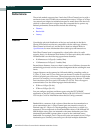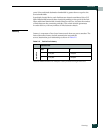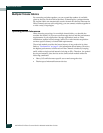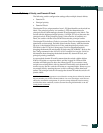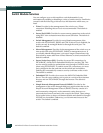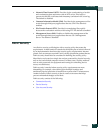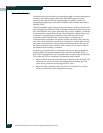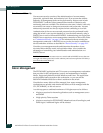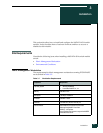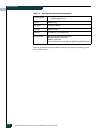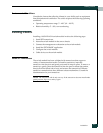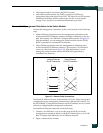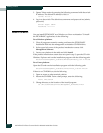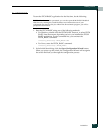
McDATA 4314 Fibre Channel Switch Module Installation Guide
2-12
Fabric Management
User Account Security
User account security consists of the administration of account names,
passwords, expiration date, and authority level. If an account has Admin
authority, all management tasks can be performed by that account in both
EFCM BASIC™ and the Telnet command line interface. Otherwise only
monitoring tasks are available. The default account name, Admin, is the only
account that can create or change account names and passwords. Account
names and passwords are always required when connecting to a switch.
Authentication of the user account and password can be performed locally
using the switch’s user account database or it can be done remotely using a
RADIUS server such as Microsoft® RADIUS. Authenticating user logins on a
RADIUS server requires a secure management connection to the switch. Refer
to “Connection Security” on page 2-10 for information about securing the
management connection. A RADIUS server can also be used to authenticate
devices and other switches as described in “Device Security” on page 2-11.
Consider your management needs and determine the number of user
accounts, their authority needs, and expiration dates. Also consider the
advantages of centralizing user administration and authentication on a
RADIUS server.
NOTE: If the same user account exists on a switch and its RADIUS server, that user
can login with either password, but the authority and account expiration will always
come from the switch database.
Fabric Management
The EFCM BASIC application and CLI execute on a management workstation
that provides for the configuration, control, and maintenance of multiple
fabrics. Supported platforms include Windows and Linux. The application
can be installed and executed on the workstation, or you can run the
McDATA Embedded Web Server that is resident on the switch.
Consider how many fabrics will be managed, how many management
workstations are needed, and whether the fabrics will be managed with the
CLI, EFCM BASIC, or the web server.
A switch supports a combined maximum of 19 logins reserved as follows:
• 4 logins or sessions for internal applications such as management server
and SNMP
• 9 high priority Telnet sessions
• 6 logins or sessions for EFCM BASIC inband and out-of-band logins, and
Telnet logins. Additional logins will be refused.



